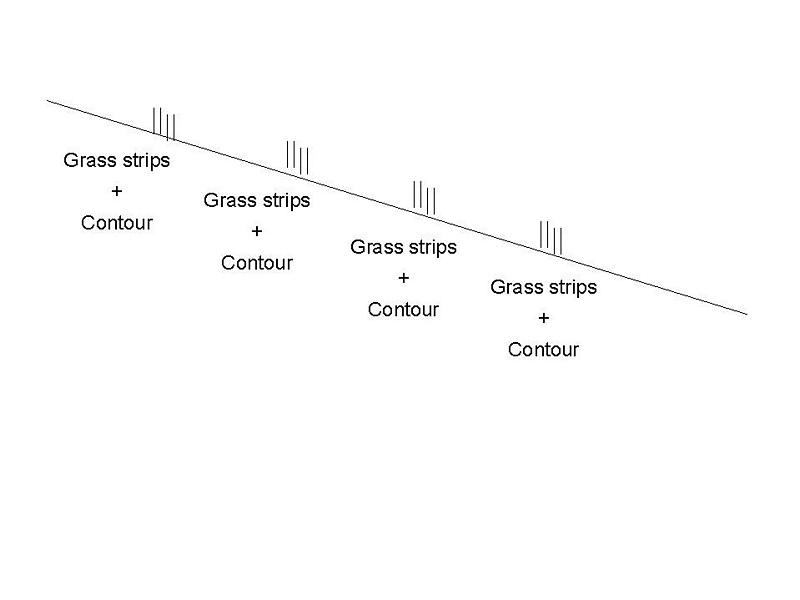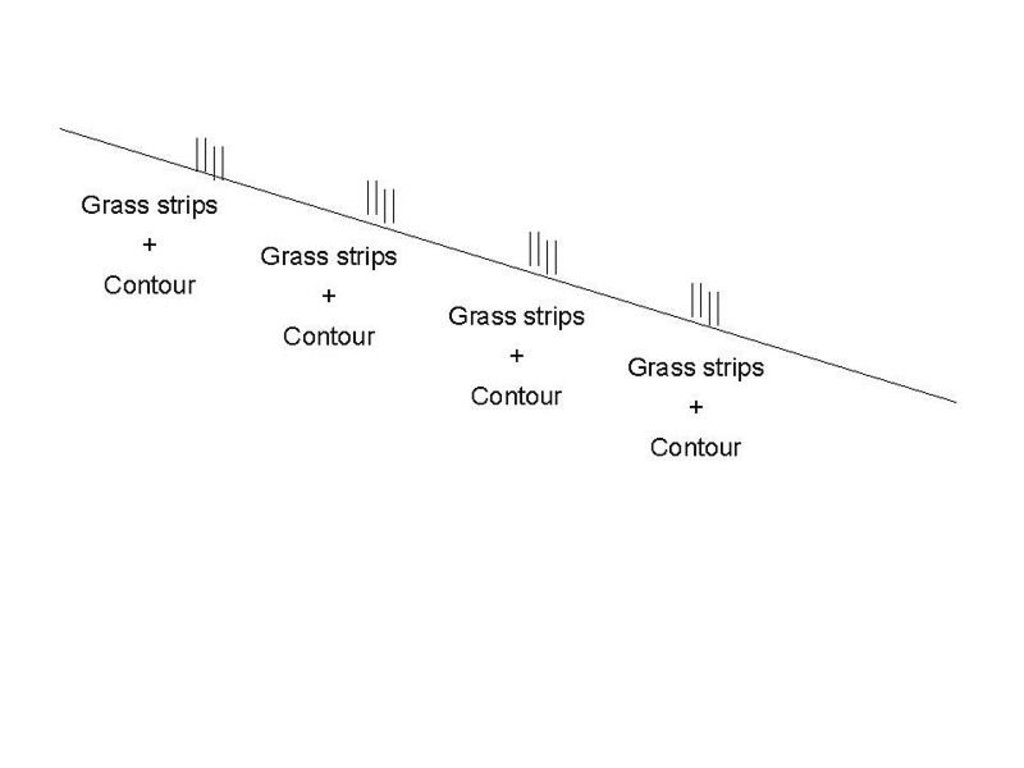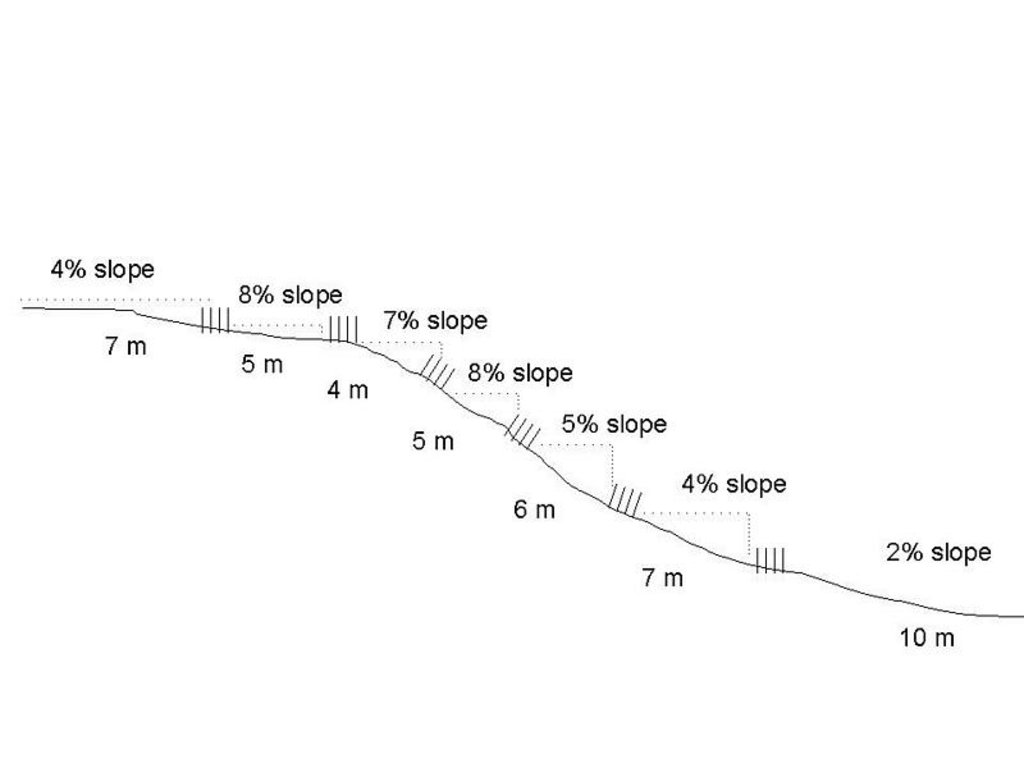Controlling of soil erosion during crop production [南非]
- 创建:
- 更新:
- 编制者: Carin Pretorius
- 编辑者: –
- 审查者: Alexandra Gavilano
technologies_950 - 南非
查看章节
全部展开 全部收起1. 一般信息
1.3 关于使用通过WOCAT记录的数据的条件
(现场)数据是什么时候汇编的?:
15/04/2004
编制者和关键资源人员接受有关使用通过WOCAT记录数据的条件。:
是
2. SLM技术的说明
2.1 技术简介
技术定义:
The technology that applies contouring, mulching and intercropping in SWC.
2.2 技术的详细说明
说明:
Agronomic technology is used to control soil erosion during the crop production period, i.e. method that is employed to improve soil fertility, conserve water and protect from soil erosion while the land is under crop production.
Purpose of the Technology: The purpose is to keep the fertility of the soil stable by protecting the soil from soil erosion and water loss.
Establishment / maintenance activities and inputs: The establishment is either done by planting strong root crops in between cultivated areas, or leaving the soil uncultivated, with a mulch cover on the soil surface. This will be maintained by keeping the intercrop strong and healthy while using zero or minimum tillage without removal of left over material on the soil surface.
2.3 技术照片
2.5 已应用该技术的、本评估所涵盖的国家/地区/地点
国家:
南非
区域/州/省:
Limpopo Province
有关地点的进一步说明:
Sekhukuneland
2.6 实施日期
如果不知道确切的年份,请说明大概的日期:
- 不到10年前(最近)
2.7 技术介绍
详细说明该技术是如何引入的:
- 通过项目/外部干预
注释(项目类型等):
Western World
3. SLM技术的分类
3.2 应用该技术的当前土地利用类型

农田
- 一年一作
注释:
Major land use problems (compiler’s opinion): Silting and low infiltration rate.
Major land use problems (land users’ perception): Injudicious cultivation.
Other grazingland: intensive grazing land
Grazingland comments: Cattle graze in the cropland during winter periods.
Type of cropping system and major crops comments: Maize mixed with groundnuts.
Maize mixed with dry beans
Type of grazing system comments: Cattle graze in the cropland during winter periods.
3.3 有关土地利用的更多信息
注释:
Water supply: mixed rainfed - irrigated, rainfed
每年的生长季节数:
- 1
具体说明:
Longest growing period in days: 120
Longest growing period from month to month: Nov - Feb
3.5 技术传播
具体说明该技术的分布:
- 均匀地分布在一个区域
如果该技术均匀地分布在一个区域上,请注明覆盖的大致区域。:
- 1-10 平方千米
注释:
Total area covered by the SLM Technology is 10 m2.
Soil conservation measures were constructed (contour banks), then but was looked after until 1980's.
3.6 包含该技术的可持续土地管理措施
3.7 该技术强调的主要土地退化类型

土壤水蚀
- Wt:表土流失/地表侵蚀
注释:
Main type of degradation addressed: Wt: loss of topsoil / surface erosion
Main causes of degradation: other human induced causes (specify) (Agricultural causes)
Secondary causes of degradation: other natural causes (avalanches, volcanic eruptions, mud flows, highly susceptible natural resources, extreme topography, etc.) specify
3.8 防止、减少或恢复土地退化
具体数量名该技术与土地退化有关的目标:
- 防止土地退化
注释:
Main goals: prevention of land degradation
4. 技术规范、实施活动、投入和成本
4.1 该技术的技术图纸
4.2 技术规范/技术图纸说明
Technical drawing off slope
Location: Mahlanga. Northern Province
Technical knowledge required for field staff / advisors: moderate
Technical knowledge required for land users: moderate
Main technical functions: control of concentrated runoff: retain / trap, control of concentrated runoff: drain / divert
4.3 有关投入和成本计算的一般信息
其它/国家货币(具体说明):
Rand
注明美元与当地货币的汇率(如相关):1美元=:
10.00
注明雇用劳工的每日平均工资成本:
6.00
4.5 技术建立所需要的费用和投入
注释:
Duration of establishment phase: 24 month(s)
4.6 维护/经常性活动
| 活动 | 措施类型 | 时间/频率 | |
|---|---|---|---|
| 1. | Conventional tillage | 农业学的 | early in rainy season / once a year |
4.7 维护/经常性活动所需要的费用和投入(每年)
注释:
Machinery/ tools: tractor/gallion
Grass strips per ha.
4.8 影响成本的最重要因素
描述影响成本的最决定性因素:
The voluntary labour was at minimal, therefore labour affected the cost significantly.
5. 自然和人文环境
5.1 气候
年降雨量
- < 250毫米
- 251-500毫米
- 501-750毫米
- 751-1,000毫米
- 1,001-1,500毫米
- 1,501-2,000毫米
- 2,001-3,000毫米
- 3,001-4,000毫米
- > 4,000毫米
农业气候带
- 半干旱
5.2 地形
平均坡度:
- 水平(0-2%)
- 缓降(3-5%)
- 平缓(6-10%)
- 滚坡(11-15%)
- 崎岖(16-30%)
- 陡峭(31-60%)
- 非常陡峭(>60%)
地形:
- 高原/平原
- 山脊
- 山坡
- 山地斜坡
- 麓坡
- 谷底
垂直分布带:
- 0-100 m a.s.l.
- 101-500 m a.s.l.
- 501-1,000 m a.s.l.
- 1,001-1,500 m a.s.l.
- 1,501-2,000 m a.s.l.
- 2,001-2,500 m a.s.l.
- 2,501-3,000 m a.s.l.
- 3,001-4,000 m a.s.l.
- > 4,000 m a.s.l.
5.3 土壤
平均土层深度:
- 非常浅(0-20厘米)
- 浅(21-50厘米)
- 中等深度(51-80厘米)
- 深(81-120厘米)
- 非常深(> 120厘米)
土壤质地(表土):
- 粗粒/轻(砂质)
表土有机质:
- 低(<1%)
5.6 应用该技术的土地使用者的特征
生产系统的市场定位:
- 生计(自给)
非农收入:
- 低于全部收入的10%
相对财富水平:
- 贫瘠
- 非常贫瘠
机械化水平:
- 机械化/电动
说明土地使用者的其他有关特征:
Population density: > 500 persons/km2
1% of the land users are average wealthy.
66% of the land users are poor.
33% of the land users are poor.
5.7 应用该技术的土地使用者拥有或租用的平均土地面积
- < 0.5 公顷
- 0.5-1 公顷
- 1-2 公顷
- 2-5公顷
- 5-15公顷
- 15-50公顷
- 50-100公顷
- 100-500公顷
- 500-1,000公顷
- 1,000-10,000公顷
- > 10,000公顷
6. 影响和结论性说明
6.1 该技术的现场影响
社会经济效应
生产
作物生产
生产区域
土地管理
社会文化影响
社区机构
生态影响
水循环/径流
地表径流
SLM之前的数量:
40
SLM之后的数量:
10
土壤
土壤水分
土壤覆盖层
土壤流失
SLM之前的数量:
0.5
SLM之后的数量:
0
6.2 该技术的场外影响已经显现
旱季稳定可靠的水流
下游洪水
6.4 成本效益分析
技术收益与技术建立成本相比如何(从土地使用者的角度看)?
短期回报:
稍微积极
长期回报:
积极
技术收益与技术维护成本/经常性成本相比如何(从土地使用者的角度看)?
短期回报:
轻度消极
长期回报:
稍微积极
6.5 技术采用
注释:
97% of land user families have adopted the Technology with external material support
350 land user families have adopted the Technology with external material support
Comments on acceptance with external material support: estimates
6.7 该技术的优点/长处/机会
| 土地使用者眼中的长处/优势/机会 |
|---|
|
Soil protection How can they be sustained / enhanced? Involve land-users right from the beginning and allow them to run the SWC on their own |
| 编制者或其他关键资源人员认为的长处/优势/机会 |
|---|
|
Control soil erosion effectively How can they be sustained / enhanced? Involve land-users right from the beginning and allow them to run the SWC on their own |
| Conserve moisture |
6.8 技术的弱点/缺点/风险及其克服方法
| 编制者或其他关键资源人员认为的弱点/缺点/风险 | 如何克服它们? |
|---|---|
| Implementation | Implement with the land users and allow the land users to own the technology |
7. 参考和链接
7.2 参考可用出版物
标题、作者、年份、ISBN:
Sustainable land use plan for Nebo-district
可以从哪里获得?成本如何?
Department of Soil Science, University of the North
链接和模块
全部展开 全部收起链接
无链接
模块
无模块




